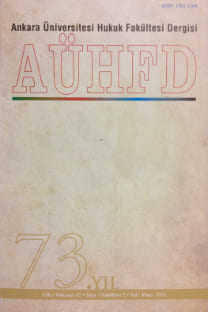GABCİKOVO-NAGYMAROS DAVASI
Macaristan ile Çekoslovakya arasında 1977 yılında yapılan andlaşma ile Tuna nehrinin bu iki ülke arasında aynı zamanda sınır oluşturan kesimi üzerinde, üç ayrı baraj ve ek tesisler yapılması kararlaştırılmıştı. Projenin uygulanmaya başlanmasından bir süre sonra Macaristan ekolojik nedenler ileri sürerek, projeyi önce askıya aldı, sonra da durdurdu. 1992 yılında da tek taraflı bildirimle 1977 Andlaşmasının sona erdiğini açıkladı. Projenin Çekoslovakya ayağında ise Gabcikovo barajının tamamlanmasının ardından, Varyant C etabı sonuçlandırılıp çalıştırılmaya başlandı. Macaristan ve Slovakya birbirlerinin yaklaşım ve eylemlerinin hukuka aykırı olduğunu ileri sürmekteydiler ve her iki tarafın dile getirdiği kaygılar içinde çevresel boyut öne çıkmaktaydı. Neredeyse silahlı çatışma noktasına kadar tırmanan gerginlik, Avrupa Topluluğu’nun arabuluculuğu neticesinde azaltılarak, uyuşmazlığın UAD (Uluslararası Adalet Divanı) önüne götürülmesi sağlandı. UAD nın, beklenen ölçüde irdelenmemiş olmakla birlikte, uluslararası çevre hukuku kavram ve ilkelerinin önemini kabul eden bir karar vermiş olması, bu davanın başlıca özelliğidir
Anahtar Kelimeler:
Uluslararası Adalet Divanı, Gabcikovo-Nagymaros davası, Slovakya, Macaristan, uluslararası çevre hukuku
Gabcikovo-Nagymaros Case
According to a bilateral agreement concluded by Hungary and Czechoslovakia in 1977, construction of three dams and additional installations over the section of the Danube which constitutes the natural boundary of these two states was targeted. After a short period upon the beginning of the implementation of the project, Hungary first suspended and then abandoned the project on the basis of ecological reasons and finally declared the termination of the 1977 Treaty in 1992. Concerning the Czechoslovakian part of the project, the Gabcikovo dam was completed and Variant C was put into operation subsequently. Both Hungary and Slovakia were accusing one and the other for their activities and environmental dimension was significant in both of the parties’ expressed concerns. The tension which escalated to the point of armed conflict was relieved as a result of the mediation of the European Community and the submission of the conflict to ICJ (International Court of Justice). The significance of this case is the ICJ’s recognition of international environmental law concepts and rules for the first time albeit it falls short in elaborating them
Keywords:
International Court of Justice, Gabcikovo-Nagymaros case, Hungary, Slovakia, international environmental law,
___
- BOSTIAN, Ida (1998): “Flushing the Danube: The World Court’s Decision Concerning the Gabcikovo Dam”, Colorado Journal of International Law and Policy, vol.9:2, s. 401-427.
- ECKSTEIN, E. G. (1995): “Application of International Water Law to Transboundary Groundwater Resources and the Slovak-Hungarian Dispute Over Gabcikovo-Nagymaros”, Suffolk Transnational Law Review, Volume 19, s. 67-105.
- ECKSTEIN, E. G./ECKSTEIN, Y. (1998): “International Water Law, Groundwater Resources and the Danube Dam Case”, paper and presentation for International Association of Hydrologists XXVII Congress and Annual Meeting of the American Institute of Hydrology, Las Vegas (Sept.27-Oct. 2), Brahana et.al (eds.) Gambling with Groundwater-Physical, Chemical and Biological Aspects of Aquifer-Stream Relations, s. 243-248. http:// www.internationalwaterlaw.org/Bibliography/Gabcikovo.html (12 Nisan 2006 tarihi itibariyle).
- FÜRST, Heiko (2004): “The Hungarian-Slovak Conflict over the Gabcikovo- Nagymaros Dams: Analysis”, Institute for Peace Research and Security Policy, University of Hamburg, Germany. s. 1-15 http://www.internationalwaterlaw. org/Bibliography/Gabcikovo.html (30 Mayıs 2006 tarihi itibariyle).
- GÜNDÜZ, Aslan (1998): Milletlerarası Hukuk, Temel Belgeler, Örnek Kararlar, Geliştirilmiş 3.baskı, Beta Yayınevi, İstanbul.
- GÜNEŞ, Şule (2001): "Karadeniz'de Çevresel İşbirliği, 1992 Bükreş Sözleşmesi", ODTÜ Gelişme Dergisi, Cilt 28, Sayı 3-4, s.311-337.
- HIGGINS, Rosalyn (2001): “Natural Resources in the Case Law of the International Court”, Boyle Alan –Freestone David (eds.), International Law and Sustainable Development, Oxford University Press, s.87-112.
- PAZARCI, Hüseyin (1999): Uluslararası Hukuk Dersleri, III.Kitap, Gözden Geçirilmiş 3.baskı, Ankara, Turhan Kitabevi.
- PAZARCI, Hüseyin (2001): Uluslararası Hukuk Dersleri, I.Kitap, Gözden Geçirilmiş 9. baskı, Ankara, Turhan Kitabevi.
- SCHAPIRO, Mark (1997): “Unquiet Flows the Danube, Hungary Sues Slovakia Over Hydroelectric Project”, NATION, March 10, 1997.
- STEC, S./ECKSTEIN, E.G. (1997): “Of Solemn Oaths and Obligations: The Environmental Impact of the ICJ’s Decision in the Case Concerning the Gabcikovo-Nagymaros Project”, Yearbook of International Environmental Law, Volume 8, Clarendon Press, s. 41-51.
- STEC, Stephen (1999): “Do Two Wrongs Make a Right? Adjudicating Sustainable Development in the Danube Dam Case”, Golden Gate University Law Review, Vol. 29, s.317-397.
- TOLUNER, Sevin (2000): Milletlerarası Hukuk Açısından Türkiye’nin Bazı Dış Politika Sorunları, Beta Yayınları, İstanbul.
- TOMKA, P./ WORDSWORTH, S. Samuel (1998): “ The First Site Visit of the International Court of Justice in Fulfillment of Its Judicial Function” American Journal of International Law, Vol. 92, No.1, s. 133-140.
- ------ Danube Dilemma: Hungary and Slovakia to Square Off at the Hague, s.1-3 http://greenhorizon.rec.org/bulletin/Bull64/cover.html (12 Nisan 2006 tarihi itibariyle).
- ----- Major Events in Slovak History: http://www.slovakia.org/history- summary.html (20 Mayıs 2006 tarihi itibariyle). BELGELER GENEL OLARAK
- Lanoux Nehri Kararı: Lac Lanoux Arbitration, Reports of International Arbitration Awards (RIAA), vol.XII, Decision of 16 November 1957, s. 285-317.
- Meuse Nehri Kararı: Diversion of the Water of the Meuse (Judgement),1937, Permanent Court of International Justice (PCIJ), Ser.A/B, No 70.
- Oder Nehri Kararı: Territorial Jurisdiction of the International Commission of the River Oder, 1929, PCIJ, Ser.A, No 23.
- Tuna’da Ulaşımın Düzenlenmesine İlişkin 1948 Tarihli Andlaşma: Convention Regarding the Regime of Navigation on the Danube, August 18, 1948, United Nations Treaty Series,197.
- ISSN: 1301-1308
- Yayın Aralığı: Yılda 4 Sayı
- Başlangıç: 1943
- Yayıncı: Ankara Üniversitesi Hukuk Fakültesi
Sayıdaki Diğer Makaleler
AT HUKUKUNA AYKIRI HUKUKİ TASARRUFLARIN İPTALİNDE KİŞİLERİN ROLÜ
VERGİ YARGILAMASINDA RE'SEN ARAŞTIRMA İLKESİ
TÜRK İDARİ TEŞKİLATINDAKİ “ADALAR”: BAĞIMSIZ İDARİ OTORİTELER
İDARİ SÖZLEŞMELERDE ÖLÇÜT SORUNU
BEDENSEL BÜTÜNLÜĞÜ İHLÂL EDİLEN EV KADINININ ÇALIŞMA GÜCÜNÜN KAYBI NEDENİYLE TAZMİN TALEBİ
